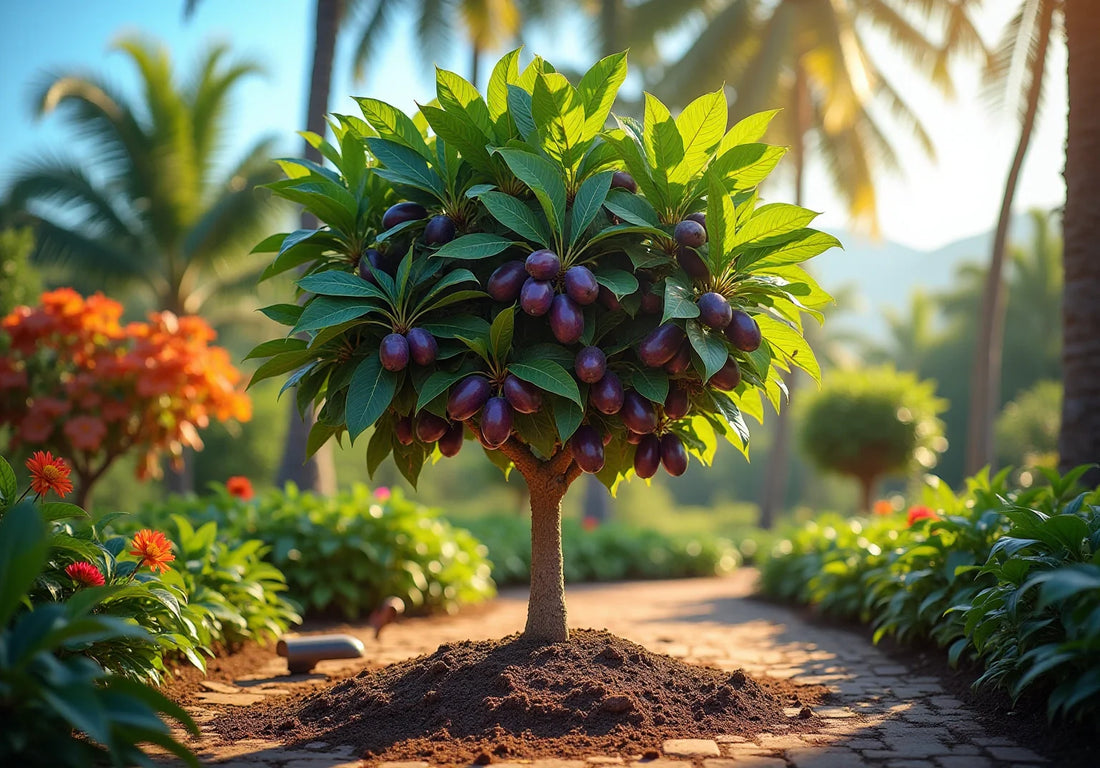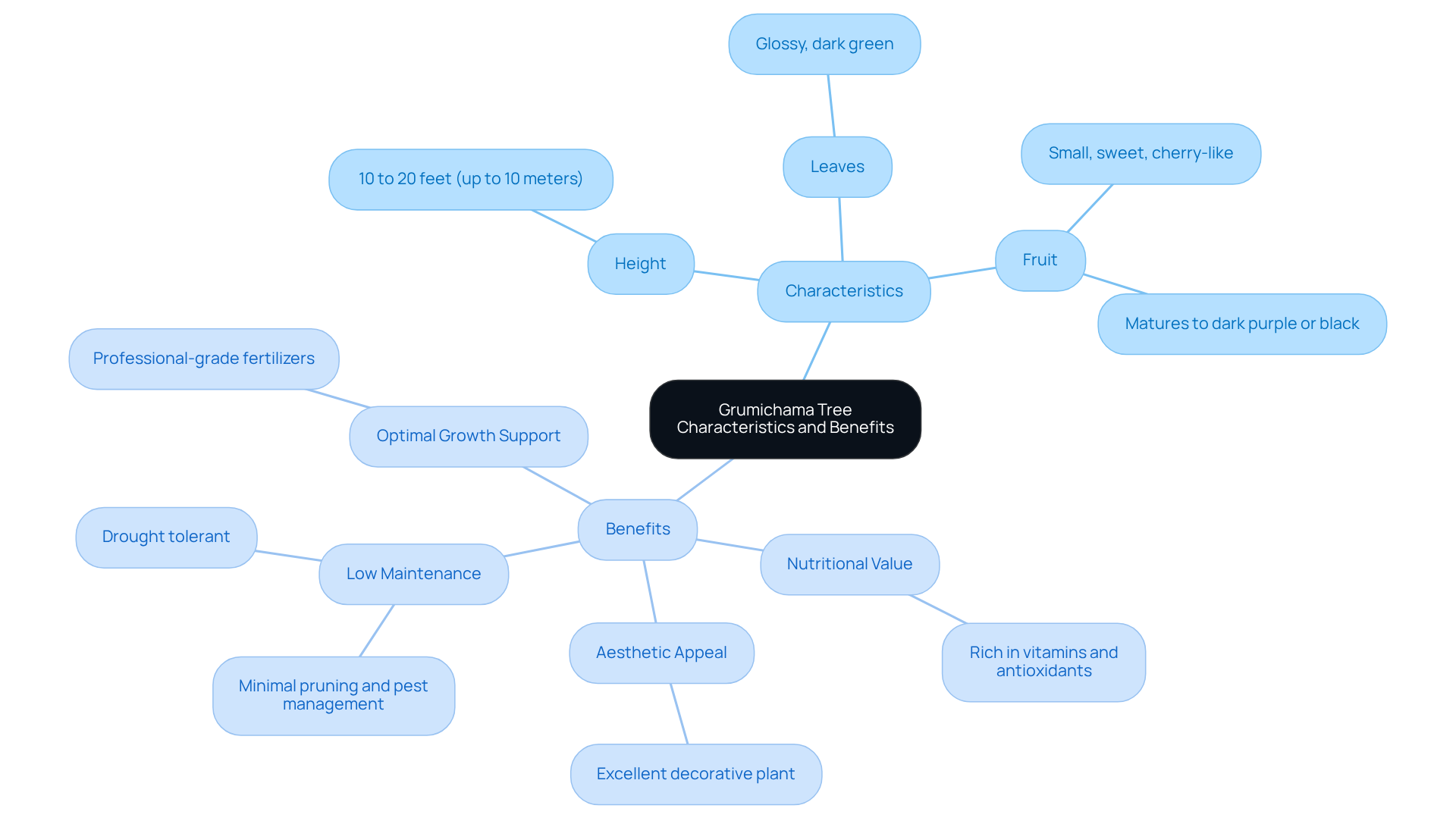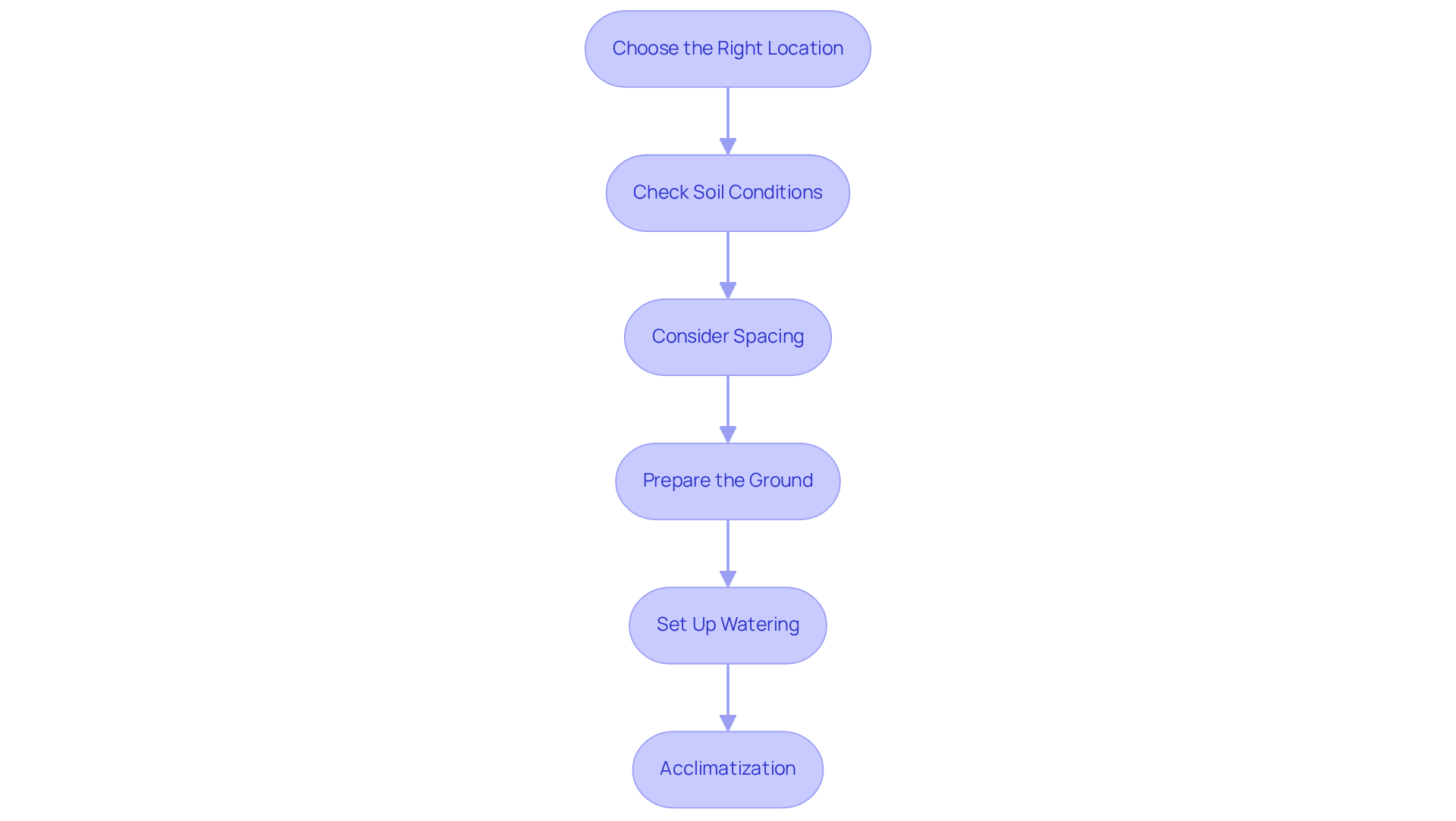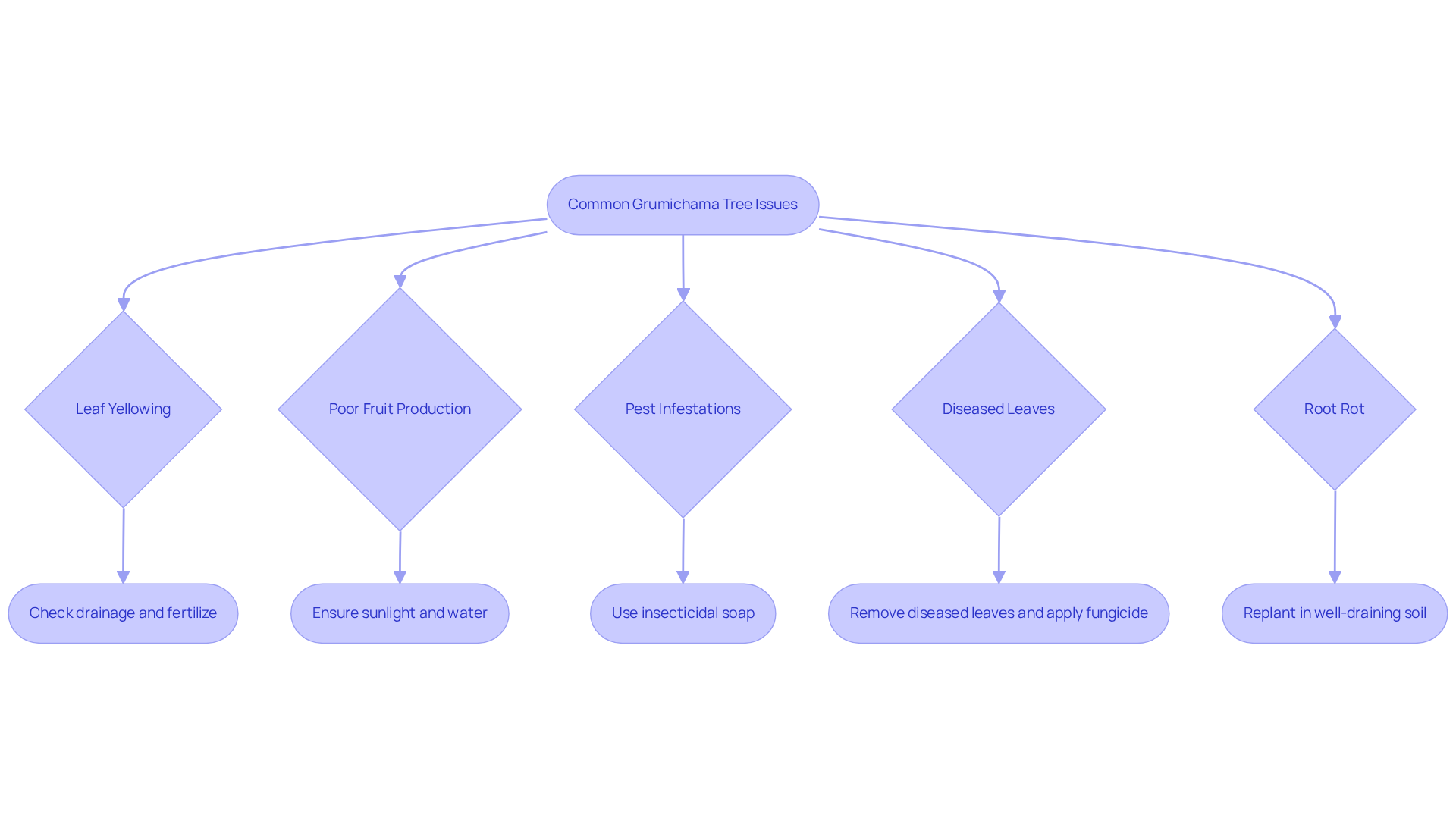
Grumichama Tree: Step-by-Step Planting and Care Guide
Share
The grumichama tree, a vibrant evergreen native to Brazil, presents not only stunning foliage but also delectable, cherry-like fruits that are abundant in vitamins and antioxidants. For home gardeners keen on enhancing their landscapes with this tropical gem, grasping its unique characteristics and care requirements is crucial.
However, challenges may arise during the planting and maintenance of this remarkable tree. How can gardeners ensure a thriving harvest?
This guide explores the step-by-step process of planting and caring for the grumichama tree, equipping readers with the essential knowledge to cultivate a healthy and fruitful addition to their gardens.
🍒 Grow Grumichama Tree (Brazilian Cherry Tree) in your garden
Explore Grumichama collection at Everglades Farm - shipped directly from Florida.
Understand the Grumichama Tree: Characteristics and Benefits
The grumichama tree, scientifically known as Eugenia brasiliensis, is a small to medium-sized evergreen plant native to Brazil. Typically growing between 10 to 20 feet tall (up to 10 meters), it features glossy, dark green leaves. This plant yields small, sweet, cherry-like fruits that mature to a dark purple or black color, offering a delightful taste reminiscent of cherries and plums. As part of Everglades Farm's Fast-Growing Trees collection, the grumichama tree is perfect for home gardeners seeking rapid-yield tropical foliage.
Benefits of the Grumichama Tree:
- The fruits from the grumichama tree are not only delicious but also rich in vitamins and antioxidants, making them a healthy addition to your diet.
- With its appealing foliage and aromatic blooms, the grumichama tree serves as an excellent decorative plant for gardens and landscapes.
- The grumichama tree is relatively easy to care for, requiring minimal pruning and pest management due to its low maintenance and drought tolerance. Once established, it can withstand periods of drought, making it suitable for novice gardeners.
- Support with professional-grade fertilizers can ensure optimal growth and fruit production for the grumichama tree, utilizing Everglades Farm's products.
By understanding these characteristics and benefits, gardeners can make informed choices about integrating this plant into their landscapes.

Prepare Your Space: Ideal Conditions for Planting
To successfully plant a Grumichama tree, it is essential to follow these steps to prepare your space effectively:
-
Choose the Right Location: Select a spot that receives full sun for at least 6 hours a day. While the tree can tolerate partial shade, optimal yields are achieved in full sunlight, ensuring the plant’s health and productivity.
-
Soil conditions for the grumichama tree show that it flourishes in well-draining, slightly acidic substrate with a pH of 5.5 to 6.5. Conduct a soil test to evaluate pH levels and enhance the earth with organic matter as necessary. This adjustment establishes optimal growing conditions. Good drainage is crucial to prevent root rot, particularly in sandy soils.
-
Space considerations are important; when planting multiple grumichama trees, ensure adequate spacing of 10 to 15 feet apart. This distance allows for suitable air circulation and growth, which are essential for the health of each plant.
-
Prepare the Ground: Before planting, loosen the earth to a depth of at least 12 inches. Incorporate compost or well-rotted manure to improve soil fertility and moisture retention, creating a nutrient-rich environment for the plant.
-
Watering Setup: Establish a consistent watering system, especially during the initial establishment phase. The grumichama tree prefers consistent moisture but should not be waterlogged; good drainage is vital to prevent root rot. Consistent watering during this phase is essential to ensure the plant establishes well.
-
Acclimatization: If starting with young plants, acclimate them to full sun before planting to avoid leaf scorching and transplant shock.
By addressing these considerations, you will create an ideal environment for your grumichama tree to thrive, ensuring a fruitful and rewarding gardening experience.

Plant the Grumichama Tree: Step-by-Step Instructions
To successfully plant your Grumichama tree, follow these detailed steps:
- Timing: The ideal planting period is during spring or fall when temperatures are moderate, promoting optimal root establishment.
- Grumichama trees flourish in slightly acidic soil with a pH of 5 to 6.5. Ensure the planting location has fertile, loamy ground for optimal results. For soursop trees, similar soil conditions are beneficial, so consider mixing organic matter to enhance fertility.
- Digging the Hole: Create a hole that is twice as wide and as deep as the plant ball. This permits the plants to expand and obtain nutrients more efficiently.
- Remove the Plant from the Pot: Gently extract the fruit-bearing plant from its container, ensuring minimal harm to the roots. If the roots are tightly bound, gently loosen them to encourage growth.
- Before planting, acclimate young plants of the grumichama tree to full sun conditions to prevent leaf scorching and minimize transplant shock. This practice is also crucial for soursop plants, which flourish in sunny environments.
- Position the Tree: Place the tree in the hole, ensuring the top of the ball is even with the surrounding earth. Avoid planting too deep to prevent decay of the plant's base.
- Backfill the Hole: Refill the hole with the dug-up material, lightly tamping it down to eliminate air pockets. Water the soil as you refill to assist it in settling around the plants.
- After planting, water the plant thoroughly to aid in root establishment. Maintain a regular watering schedule, especially during dry periods, to support growth. Remember, the grumichama tree has a growth rate of 1 to 2 feet annually, so consistent care is crucial. For soursop plants, ensure they receive adequate moisture, particularly during flowering and fruiting stages.
- Mulching: Apply a layer of organic mulch around the base of the plant, keeping it a few inches away from the trunk. This aids in holding moisture and preventing weeds, fostering a healthier habitat for your fruit-bearing plant. Mulching is also advantageous for soursop plants, as it aids in regulating soil temperature and moisture.
- Pest Awareness: Be aware that this fruit can be vulnerable to fruit fly infestations, which may destroy a considerable portion of the crop. Implementing protective measures, such as netting, can help safeguard your harvest. Likewise, soursop plants may encounter pest challenges, so consider organic pest management strategies, such as introducing beneficial insects or using neem oil, to safeguard your crops.
By following these steps, you will ensure that your fruit plant is positioned correctly, creating the foundation for strong growth and abundant harvests, while also implementing best practices that support other tropical fruit plants like soursop.
Maintain Your Grumichama Tree: Care and Maintenance Tips
To ensure the health and productivity of your Grumichama tree, it is essential to follow these care and maintenance tips:
-
Watering Schedule: Water the tree deeply every 1-2 weeks, especially during dry spells. Aim for a 'deep soak' that lasts about 40 minutes to reach depths of 12-24 inches. Allow the ground to dry slightly between waterings to prevent excess moisture, which can lead to root decay and other complications.
-
Fertilization: Apply a balanced fertilizer twice a year—once in early spring and again in late summer. In the third year, consider using 1 ½ to 2 cups of a 10-10-10 fertilizer per plant, spreading it evenly in a 5 to 6-foot diameter area. If soil phosphorus levels are below optimal, add superphosphate (0-20-0) at a rate of 1 to 2 oz. (1/8 to ¼ cup).
-
Pruning: Minimal trimming is necessary; however, shaping the plant and removing any dead or diseased branches is beneficial. Prune after fruiting to stimulate new growth and maintain the plant's health.
-
Pest Management: Monitor for common pests such as aphids and mealybugs. If infestations occur, manage them with organic insecticidal soap or neem oil to protect your plant without using harsh chemicals. Additionally, when planting your grumichama tree, ensure it is positioned in full sun and well-draining soil, as these factors are crucial for preventing pest issues and promoting healthy growth.
-
Mulching: Apply a layer of mulch around the base of the plant to retain moisture, suppress weeds, and regulate soil temperature, which is vital for healthy growth.
-
Harvesting: The fruits typically ripen from late spring to summer. Harvest them when they are dark purple or black and slightly soft to the touch for optimal flavor.
By following these maintenance suggestions, including appropriate planting techniques and pest control strategies, you can ensure that your fruit-bearing plant remains healthy and produces abundant yields for many years to come.
Troubleshoot Common Issues: Solutions for a Healthy Tree
Common issues you may encounter with your Grumichama tree and their solutions include the following:
-
Leaf Yellowing: This issue often indicates overwatering or nutrient deficiencies. Ensure proper drainage and consider applying a balanced fertilizer. Conducting soil tests bi-annually can help monitor pH and nutrient levels, ensuring your plant receives the necessary nutrients.
-
Poor Fruit Production: If your plant is not producing fruit, check for adequate sunlight and water. Grumichama trees typically require four to five years to reach maturity for fruiting, so patience is essential. Remember, larger plants are more likely to yield fruit, as plant size significantly impacts fruit production.
-
Pest Infestations: Regularly examine your plant for pests. Utilize organic treatments like insecticidal soap to manage infestations effectively. Additionally, consider introducing natural predators, such as ladybugs, to help control pest populations.
-
Diseased Leaves: If you notice spots or wilting leaves, this may indicate a fungal infection. Remove affected leaves and apply a fungicide if necessary to prevent further spread.
-
Root Rot: Ensure the plant is not resting in waterlogged soil. If root rot occurs, eliminate the plant, trim away affected roots, and replant in well-draining soil.
By being proactive and addressing these common issues, you can ensure that your Grumichama tree remains healthy and thrives in your garden.

Conclusion
The grumichama tree is celebrated for its delightful cherry-like fruits and attractive evergreen foliage, making it an excellent choice for gardeners eager to enhance their landscapes while enjoying the benefits of homegrown produce. By understanding its unique characteristics and requirements, individuals can successfully cultivate this tropical gem and reap its rewards for years to come.
This guide has thoroughly discussed key aspects such as ideal planting conditions, step-by-step planting instructions, and essential care tips. Each element, from selecting the right location and soil to ensuring proper watering and pest management, plays a crucial role in the successful growth of the grumichama tree. The insights provided empower gardeners to make informed decisions that foster healthy development and fruitful harvests.
In conclusion, the grumichama tree not only offers aesthetic appeal and nutritious fruit but also represents an opportunity for gardeners to engage with nature and cultivate their green thumbs. By adhering to the outlined steps and remaining vigilant against common issues, anyone can create a thriving environment for this remarkable plant. Embrace the challenge of planting and caring for the grumichama tree, and unlock the potential of your garden with this rewarding addition.
Transform Your Garden with the Grumichama Tree!
Start your journey to homegrown delights and vibrant landscapes with Everglades Farm today.
🛒 Explore Red Grumichama Brazilian Cherry Plant
🛒 Explore Yellow Grumichama Brazilian Cherry Plant
Frequently Asked Questions
What is the grumichama tree?
The grumichama tree, scientifically known as Eugenia brasiliensis, is a small to medium-sized evergreen plant native to Brazil, typically growing between 10 to 20 feet tall. It features glossy, dark green leaves and produces small, sweet, cherry-like fruits that mature to a dark purple or black color.
What are the benefits of the grumichama tree?
The grumichama tree produces delicious fruits that are rich in vitamins and antioxidants, making them a healthy dietary addition. It also serves as an attractive decorative plant due to its appealing foliage and aromatic blooms. Additionally, it is low maintenance, drought tolerant, and easy to care for, making it suitable for novice gardeners.
What conditions are ideal for planting a grumichama tree?
The grumichama tree thrives in full sun for at least 6 hours a day, although it can tolerate partial shade. It prefers well-draining, slightly acidic soil with a pH of 5.5 to 6.5. Proper spacing of 10 to 15 feet apart is recommended for multiple trees to ensure good air circulation and growth.
How should I prepare the ground for planting a grumichama tree?
Before planting, loosen the soil to a depth of at least 12 inches and incorporate compost or well-rotted manure to enhance fertility and moisture retention. This creates a nutrient-rich environment for the plant.
What watering practices should I follow for a grumichama tree?
Establish a consistent watering system, especially during the initial establishment phase. The tree prefers consistent moisture but should not be waterlogged, as good drainage is crucial to prevent root rot.
How can I acclimate young grumichama plants before planting?
Young plants should be acclimated to full sun before planting to avoid leaf scorching and transplant shock. This gradual exposure helps the plants adjust to their new environment.


